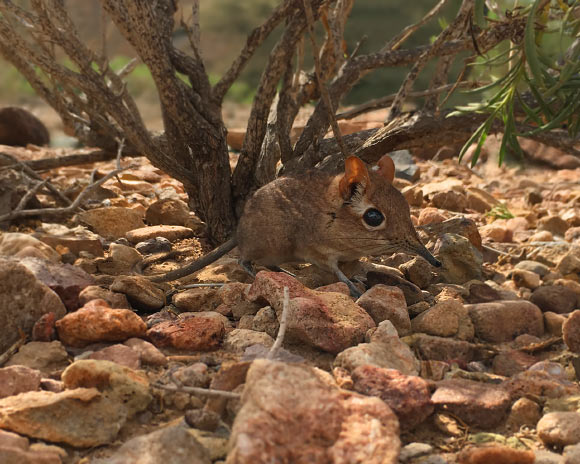A team of researchers from the United States and the Republic of Djibouti has rediscovered the elusive Somali sengi (‘Elephantulus’ revoilii) over 50 years after it was last recorded. While this species, also known as the Somali elephant-shrew, is historically documented as endemic to Somalia, the new records are from the neighboring Republic of Djibouti and thus expand the species’ known range in the Horn of Africa.

A Somali sengi (Galegeeska revoilii) at the Assamo locality in Djibouti. As is observed in other sengi species, Somali sengis have some variation in pelage colors. These differences seem to correspond to the color variation of substrates between occurrence localities. At the Assamo site, in the extreme southeastern corner of Djibouti, sengi habitats are comprised of rocks with more rusty coloration than elsewhere in the country. Compared to other Djiboutian sites, sengis from Assamo have dorsal pelage hairs with more pronounced reds. Image credit: Steven Heritage.
The twenty living species of elephant-shrews, more properly called sengis, are African mammals that comprise the order Macroscelidea and are closely related to aardvarks, golden-moles and tenrecs.
These creatures are predominantly insect-eaters and all are small bodied with various species ranging from mouse to squirrel sizes.
They are remarkably adapted runners, with some species able to bound at nearly 30 km/h and with leg proportions closer to gazelles than other small mammals.
All sengis studied so far are socially monogamous with pairs that mate for life and that share relatively well-defined home ranges.
Among the least-known species is the Somali sengi, which is primarily known from about 39 museum specimens, with no new occurrence records since 1968.
In 2017, the Global Wildlife Conservation identified it as a Top 25 Most Wanted animal in their Search for Lost Species initiative.
Two years later, Dr. Steven Heritage from the Division of Fossil Primates in the Duke Lemur Center at Duke University and his colleagues set out to see if the Somali sengi was still around, and maybe hanging out somewhere else in eastern Africa other than Somalia.
The researchers set up 1,259 traps at 12 localities in four administrative regions (Arta, Dikhil, Tadjourah, and Ali Sabieh) of the Republic of Djibouti, to the northwest and adjacent to northern Somalia.
They recovered 263 spiny mice, 17 gerbils, one gundi, and 8 Somali sengis.
“It was amazing. When we opened the first trap and saw the little tuft of hair on the tip of its tail, we just looked at one another and couldn’t believe it,” Dr. Heritage said.
“A number of small mammal surveys since the 1970s did not find the Somali sengi in Djibouti — it was serendipitous that it happened so quickly for us.”
“For us living in Djibouti, and by extension the Horn of Africa, we never considered the sengis to be ‘lost,’ but this new research does bring the Somali sengi back into the scientific community, which we value,” said Houssein Rayaleh, a researcher with Association Djibouti Nature.
“For Djibouti this is an important story that highlights the great biodiversity of the country and the region and shows that there are opportunities for new science and research here.”
“Our occurrence locality data very near the adjoined borders of Djibouti, Somalia, and Ethiopia strongly suggests that the Somali sengi is a current inhabitant of all three countries,” the scientists said.
“The finding should move the sengis from ‘Data Deficient’ to ‘Least Concern,’ on the lists.”
After some careful DNA and anatomical analyses of the captured animals, the team not only confirmed that the species was alive and well, but also found that it had been mis-classified by scientists, probably because of the sparse data.
“This taxonomic issue is resolved by recognizing a new genus replacement and recombinant binomial that redesignates the Somali sengi as Galegeeska revoilii,” the authors said.
“An analysis of ancestral biogeography suggests that the Somali sengi has inhabited the Horn of Africa for more than 5.4 million years — and the recognition of the species’ phylogenetic ancestry appends the already remarkable biogeographic story of the tribe Macroscelidini.”
The team’s paper was published in the journal PeerJ.
_____
S. Heritage et al. 2020. New records of a lost species and a geographic range expansion for sengis in the Horn of Africa. PeerJ 8: e9652; doi: 10.7717/peerj.9652







